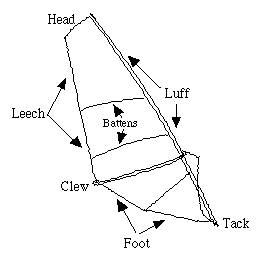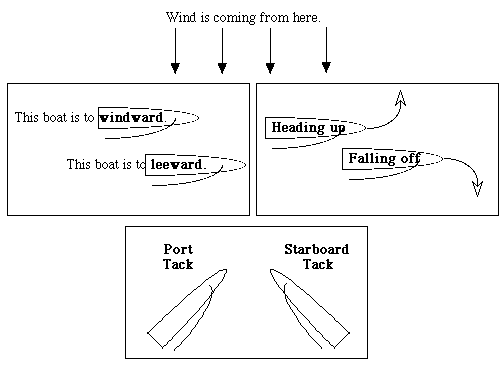Sailing is full of terminology. Knowing the terms makes learning to sail easier. For example, if someone frantically yells to you, "fall-off," they do not mean to gracelessly dismount from your board. The following terms are used frequently and all windsurfers should know them.
Terms can be broken into parts of the sail and rig; parts of the board; points of sail; and directions. These sections are followed by a more or less complete glossary of sailboard terms.
The long skinny pole that holds the sail up is the mast. The booms are the two sticks, one on each side of the sail, that hold the sail out from the mast.
Sails have 3 corners (head, tack, clew) and 3 slides (luff, leech, foot):
Three ropes (or 'lines') are attached to the sail. The downhaul pulls the sail down the mast. It is attached to the tack of the sail. It is the most important rope for adjusting the sail. The outhaul pulls the sail out the boom. Finally, your friendly uphaul is the rope that you use to pull the sail up out of the water.
The battens are flexible plastic strips or tubes that hold the shape in the sail.
The fin (or skeg) and the centerboard provide lateral resistance and keep the board from going sideways. The universal is a flexible joint that attaches the mast to the board. The pointy (foreward) end of the board is the bow, the other (back) end is the stern.

It is necessary to describe the direction a sailboard is travelling, relative to the wind direction. When you start up, you will be on a beam reach. You will notice in the figure below that you cannot sail directly in the direction that the wind is coming from. To get up wind, you will need to sail on a close reach and ziz-zag back and forth (tack). Sailing directly downwind on a run will give you a tippy ride, but is a necessary skill to learn in order to master the jibe. 
Directions on the water can be described in terms relative to the wind, or relative to 'left' and 'right.' Since we've always had trouble with the latter, we will begin with terms relative to the wind.
The direction from where the wind is blowing is windward. The direction away from where the wind is blowing is leeward.To change one's direction to point more toward the wind is to head-up. To change one's direction to point more away from the wind is to fall-off. Now you know when someone frantically yells at you "fall-off," they do not mean hit the suds.
Now it's time for (ugh) left and right. If the wind is coming over the right side of a sailboard, therefore the sailor' right hand is forward, the sailboard is on starboard tack. If the wind is coming over the left side of a sailboard, therefore the sailor' left hand is forward, the sailboard is on port tack.
Sailing directions are important for Rules of the Road which are covered in the 'Start-Up' section of this guide.>
Glossary of Sailing Terms
- Apparent wind
- The wind that the sailor feels which is the combination of the true wind and the wind caused by the boat's movement through the water.
- Battens
- Flexible strips or tubes placed in pockets in the sail to hold the sail's shape.
- Beam
- Widest part of a boat. The point halfway between the bow (front) and stern (rear) of a sailboard.
- Beam reach
- Sailing at 90 degrees to the wind. Sailing with the wind coming directly over the beam of the board.
- Bear off
- Same as 'fall off.'
- Beat
- To sail to windward.
- Broad Reach
- Sailing with the wind just aft of the beam.
- Camber induced sail, Camber inducers
- Plastic devices that hold the sail away from the mast so that there is a smooth flow of air across the mast to the sail on both the windward and leeward sides of the sail.
- Center of effort (CE)
- Point at which all of the force of the wind can be thought to concentrate.
- Center of lateral resistance (CLR)
- Point at which all of the sideways motion of the board may be thought to be concentrated. On the boards that have centerboards, the CLR is approximately at the centerboard.
- Centerboard
- A retractable device that, when down, keeps the board from going sideways. Entry-level boards have centerboards. Without a centerboard (in the down position) a novice board will not sail up wind. The centerboard will also steady the board and make balance easier.
- Close reach
- The point of sail between close-hauled and a beam reach.
- Come about, tack
- To change direction so that the sail is flown in the opposite side by turning through the eye of the wind.
- Downhaul
- Line that is used to pull down the mast. On modern sailboards, correct tension in the downhaul is the most critical sail adjustment. See how to rig sails section.
- Eye of the wind
- Direction from which the wind is blowing.
- Fall off
- No this does not mean jump off your board. It means to change direction so as to point farther away from where the wind is coming from.
- Head up
- Change direction so as to point closer to where the wind is coming from.
- Jibe
- To change direction so that the sail is flown on the opposite side by turning away from the wind.
- Leeward
- Direction away from the wind. In the Rules of the Road, the leeward boat is the one farthest from where the wind is coming from.
- Outhaul
- Line that us used to attach the sail to the end of the boom.
- Uphaul
- (1) Pull the sail out of the water. (2) The line that sailors use to pull the sail out of the water.
- Port tack
- In the normal sailing stance, sailing a course with the left hand in front. The wind will be coming from the left (port) side of the board. Port tack boat must stay out of the way of starboard tack boat.
- Rotating asymmetrical foil (RAF) sails
- Full batten sails without camber inducers. The batten tucks part way behind the mast so that there is a smooth airflow on the leeward side of the sail. Usually less expensive than camber induced sails.
- Rules of the road
- Rules that govern right-of-way when two boats meet (`boats' includes windsurfers)
- Running
- Sailing in the same direction as the wind.
- Sheet in
- Pull the sail in by pulling in with the back hand. On a boat, the sheet is the line (rope) that controls the sail. Boat sailors control the sail by pulling on the sheet. Windsurfers sheet the sail primarily with their back hand.
- Sheet out
- The opposite of sheet in.
- Skeg, fin
- The small fluke or appendage in the water at the stern of the board that keeps the board going straight. Do not attempt to sail a board without a skeg.
- Starboard tack
- In the normal sailing stance, sailing a course with the right hand in front. The wind will be coming from the right (starboard) side of the board. If two sailboats or sailboards meet, the one on starboard tack has the right-of-way.
- Windward
- Direction toward the wind. The windward boat is the one closest where the wind is coming from.
- Universal
- The joint that connects the mast to the board. It can rotate in all directions, hence universal.



